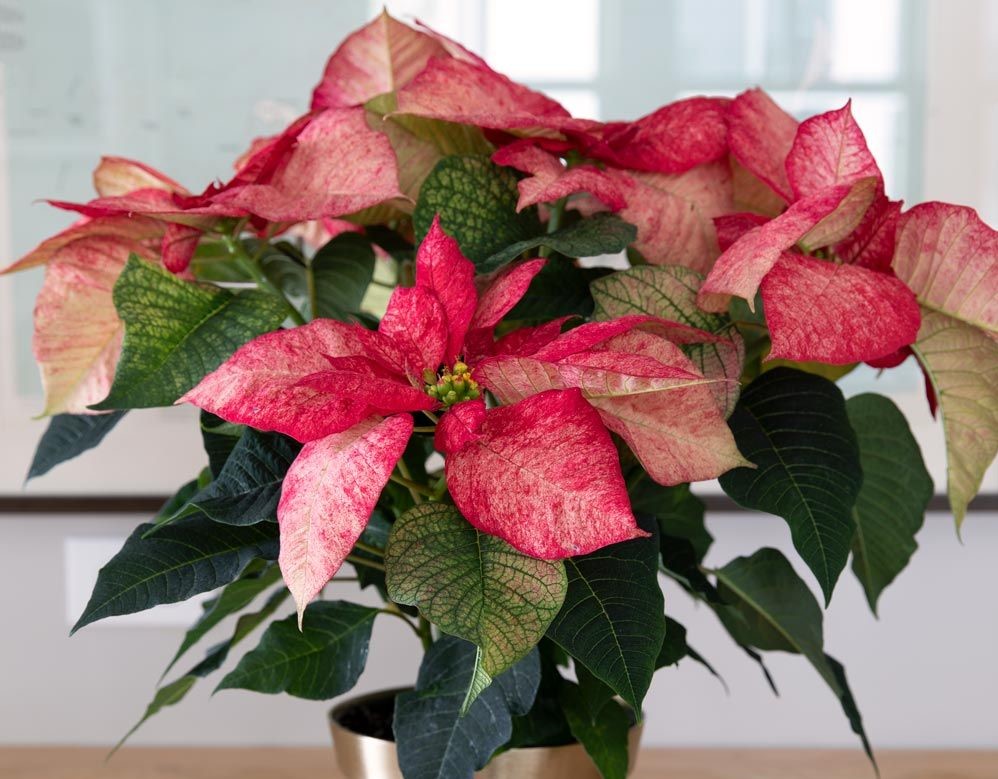No flower signifies the holidays more than the poinsettia. A December blooming bush native to Mexico, it was discovered in the early 1800s by Joel Roberts Poinsett while serving as US Ambassador to Mexico. Being a botanist, Poinsett brought cuttings of this new species home to South Carolina, which introduced poinsettias to the US. The plant was eventually named after the Ambassador. However, it was Paul Ecke, Sr., a California farmer, who is responsible for making poinsettias the most popular holiday plant. Using grafting technology, the Paul Ecke Ranch turned the original native plant into countless varieties of multi-branched plants with long-lasting color.
More than 100 varieties are available today and come in multiple colors: red, white, pink, marbled and speckled. The colored parts of the poinsettia are often mistaken as the flowers but are actually colored bracts (modified leaves). The true flowers are in the center of the colored bracts (see photo).
To check a poinsettia’s maturity, examine the color of the true flowers. If the flowers are green or red-tipped and fresh looking, the bloom will “hold” longer than if yellow pollen is covering the flowers. Poinsettias will drop their bracts and leaves soon after the flowers shed the yellow pollen, so be sure to purchase plants whose flowers have little or no yellow pollen showing.
To help your poinsettias last throughout the holiday season, keep in mind the following tips when selecting plants:
- The plant should have dark green foliage down to the soil line.
- The bracts should be completely colored without a lot of green around the edges.
- Avoid plants with wilted, fallen or yellowed leaves.
- If the plant’s soil is wet and the plant is wilted, this may be an indication of root rot.
- Check undersides of leaves for insects like aphids and whiteflies
- When taking the poinsettia home, have it sleeved or covered if outdoor temperatures are below 50°F.
Once home, the conditions you provide will determine how long your poinsettias will last:
- 6 hours of indirect light is ideal to maintain the brightest bract color. If placed near a sunny window, make sure the plant does not touch cold windowpanes.
- Keep the plant away from warm or cold drafts (near HVAC vents, doors, windows, etc.).
- Ideal daytime temps of 60°-70° and nighttime temps of 55°-60° will extend the life and bloom time of the plant. Avoid temps higher than 70°, which shorten plant life.
- Check the soil daily and water only when dry. Make sure the water drains into a saucer and then discard. Allowing the plant to wilt, causes bracts and leaves to drop.
- Do not fertilize while the plant is in bloom. If you keep the plant after the holiday season, begin monthly applications of a houseplant fertilizer.
- Poinsettias should last 6-8 weeks with proper care.
Poinsettias are part of the Euphorbiaceae or Spurge family. Many plants in this family produce a milky sap which may cause a skin reaction in some people with latex allergies. For pets, the poinsettia sap may cause mild irritation or nausea, so it’s probably best to keep pets away from the plant, especially puppies and kittens
Buying a young plant and providing proper light, temperature and water, should help your poinsettias retain their beauty throughout the holiday season and beyond.

